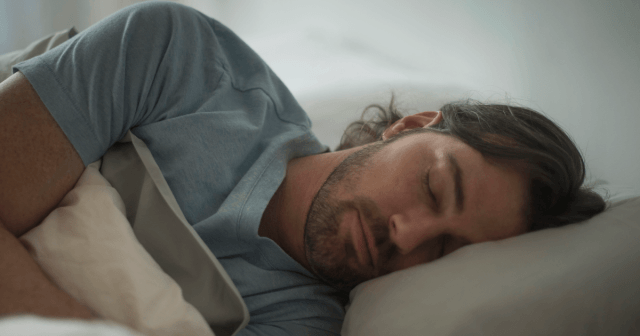When you snuggle up to sleep at night, did you know that there is a part of your body that is hard at work? Yes, your parasympathetic nervous system is busy making sure you are ready to relax and get the most out of your rest.
In fact, this system is always active, helping us to ‘keep calm and carry on’, especially after we’ve been stressed (such as running late for a meeting) or shocked (had a surprise birthday party thrown for us). So, what exactly is our parasympathetic nervous system, and why is it so important for our heart rate and sleep? Here’s your guide to helping your body keep its cool.
What is the parasympathetic nervous system?

The parasympathetic nervous system (PSNS) is part of your autonomic nervous system, which regulates your automatic body functions, such as heart rate, metabolism, and body temperature.
Your PSNS is all about slowing your body down, helping it to relax and rebalance, especially after anything stimulating has occurred. When you feel your heart rate begin to slow or the tension leaves your muscles after you’ve had a shock or been stressed, this is your PSNS in action.
Rest and digest vs. fight or flight
The parasympathetic nervous system works in balance with your sympathetic nervous system (SNS), with each one automatically helping your body adapt to our constantly changing environments.
Your parasympathetic nervous system takes over when your system feels it can return to ‘business as usual’, helping your various bodily functions find their usual rhythm again.
Your SNS takes over when we perceive that we are under threat (real or otherwise). It speeds up our heart rate, makes us tense and ready to spring into action. This is why your SNS is associated with our physiological ‘fight or flight’ response, which is triggered when we are stressed, frightened, or experience a situation of danger.
Your PSNS takes over when your system feels it can return to ‘business as usual’, helping your various bodily functions find their usual rhythm again. Our breathing slows and becomes deeper, and our digestive system becomes active again, among other functions. This is why your PSNS is often referred to as your ‘rest and digest’ response, in contrast to your SNS.
Parasympathetic effect on heart rate

Your SNS and PSNS work together to control your heart rate. When your body needs to increase your heart rate, your SNS releases catecholamine hormones (epinephrine and norepinephrine) to enable this acceleration. Then, when your body needs your heart rate to decrease, your PSNS releases the hormone acetylcholine to slow it down.
When we are stressed, excited, or have taken a stimulant such as caffeine, our heart rate will naturally rise. However, when we are constantly stressed or stimulating our bodies, we can frequently experience symptoms such as anxiety and heart palpitations. So, we mustn’t live our lives constantly running on adrenaline but instead find ways to relax and allow our PSNS to return our body to a state of everyday calm, known as homeostasis.
ACTIVATING THE PARASYMPATHETIC NERVOUS SYSTEM
A great way to decrease the stress and anxiety in our lives is to activate our PSNS. We can achieve this through many different calming practices:
- Deep breathing: focus on taking breathes all the way down into your belly that expands your diaphragm as you inhale.
- Meditating: spend 10 minutes quieting your mind and focussing on your breathing.
- Touching your lips: this part of the body has many parasympathetic fibers running through them. By running your fingers across your lips, you will stimulate your PSNS.
- Trying a gentle movement practice such as yoga, qigong, or tai chi.
- Doing an inversion, such as a handstand or a headstand.
- Light stretching.
- Having a massage.
- Going for a walk in nature.
- Regular light to moderate aerobic exercise.
Parasympathetic nervous system and exercise
Obviously, when we exercise, we activate our SNS to raise our heart rate. So, how can regular exercise help our PSNS?
Well, for starters, it is still hard at work when we’re active, even if our SNS is dominating. Your PSNS ensures that all the changes to your breathing, sweat production, and heart rate happen gradually. Otherwise, we’d find our bodily responses jumping about uncontrollably.
Your parasympathetic nervous system ensures that all the changes to your breathing, sweat production, and heart rate happen gradually.
Our PSNS is also boosted by regular exercise because it produces endorphins. These happy hormones are great at helping us feel relaxed because they signal to the body that we aren’t in physical danger, enhancing our ability to relax back into homeostasis once we have stopped being momentarily stressed or excited.
Of course, your exercise plan should be all about balance. If you are only ever working out at a high intensity, you are constantly placing your body and nervous system under stress. Try to mix these sessions up with light to moderate-intensity exercise for at least 30 minutes on other days.
Parasympathetic nervous system and sleep

As you can imagine, the ‘rest and digest’ division of our autonomic nervous system is essential for our capacity to get a good night’s sleep. Our SNS and PSNS are constantly active, but there are certain times when it is vital that one or the other dominates.
When it comes to sleep, ensuring our PSNS is activated is critical. We all know that trying to sleep when your body or mind feels stressed is much more difficult. If the events of our day have caused our SNS to dominate, your body will still be tense, and your mind will be racing. This will result in a poor night’s sleep, as our body struggles to relax and recover properly.
Nightly Recharge™ is a great way to measure how well your PSNS was able to take over your rest and recovery each evening. The feature looks at how the status of your autonomic nervous system and the amount and quality of your sleep compared to your usual night.
If you often find yourself struggling to fall asleep or scoring a poor rating with your ANS Charge, here are some ways you can assist your PSNS before going to bed each night:
- Try a sleep meditation or breathing exercise before bed.
- Use a weighted blanket (the pressure can help activate your PSNS).
- Avoid alcohol and late-night snacks/meals.
- Create the right sleep environment to enhance your ability to rest.
If you liked this post, don’t forget to share so that others can find it, too.
Or give it a thumbs up!
I like this article
Please note that the information provided in the Polar Blog articles cannot replace individual advice from health professionals. Please consult your physician before starting a new fitness program.





